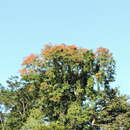en
names in breadcrumbs


Bernoullia is a genus of tropical trees in the mallow family, Malvaceae. It was established by English botanist Daniel Oliver in 1873. There are three accepted species, which occur from Mexico to Colombia.[2]
Nuclear DNA studies suggest that Bernoullia and the genera Gyranthera and Huberodendron form a sister clade to a core Bombacoideae clade.[3] Members of this genus have indehiscent fruits — that is, they do not split open when ripe to release their seeds. The staminal filaments of the flowers are fused into a tube, with the unstalked anthers located near the tube's apex. The pollen is somewhat triangular in shape, with furrows and/or pores on the surface.[3]
Bernoullia is a genus of tropical trees in the mallow family, Malvaceae. It was established by English botanist Daniel Oliver in 1873. There are three accepted species, which occur from Mexico to Colombia.
Bernoullia flammea Bernoullia jaliscana Bernoullia uribeanaNuclear DNA studies suggest that Bernoullia and the genera Gyranthera and Huberodendron form a sister clade to a core Bombacoideae clade. Members of this genus have indehiscent fruits — that is, they do not split open when ripe to release their seeds. The staminal filaments of the flowers are fused into a tube, with the unstalked anthers located near the tube's apex. The pollen is somewhat triangular in shape, with furrows and/or pores on the surface.